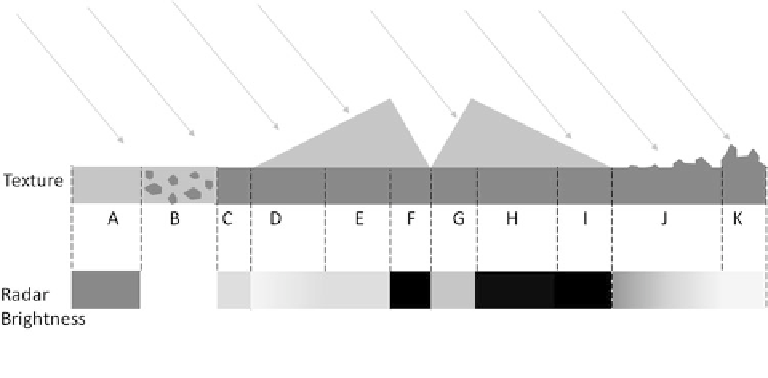Geoscience Reference
In-Depth Information
Fig. 18.22
A schematic of the radar-brightness (bottom bar: white
indicates a strong reflection, black a weak one) as a function of surface
texture. In the surface texture schematic, light grey indicates low
dielectric constant material like loose, dry sand, whereas packed clay
or rock is shown as dark grey. Radar energy illuminates the surface
from upper left as shown by arrows. A deep loose sand surface (A)is
somewhat dark, whereas if the sand contains many boulders larger
than the wavelength scale (B) the reflection can be bright due to
volume scattering—remarkably bright in some cases where the
reflections are coherent. A rock or other dense substrate (C) gives a
brighter reflection (all else being equal) than a sand substrate (A).
Radar energy can penetrate a thin layer of sand, and in fact the sand
can focus the energy leading to a strong reflection (D). If a smooth
dune facet (D, E) is almost normal to the incident radar energy, a
strong reflection will result, often seen as a glint in a radar image. In
contrast, facets inclined away from the beam will reflect very little
energy back to the radar and so will be dark (F, H). The brightness is a
function of angle (see Fig.
18.20
), thus the facet at G is inclined
further from the beam than at E and so is slightly darker; this angular
dependence is the basis for radarclinometry. Note that the thin sand-
on-substrate at I is still dark to a monostatic radar; even though the
surface reflects energy, most is going away from the sensor. A given
rough horizontal surface illuminated by an inclined beam will
generally be brighter the larger the roughness (J-K). Note that dunes
with different stoss and lee slopes in the plane containing the radar
beam will generate an anisotropy even if the individual features
cannot be resolved—the brightness averaged over D-E-F is substan-
tially higher than G-H-I. Such an anisotropy has been used to infer
small dune textures in Magellan images of Venus (see
Sect. 18.3
).
Different surfaces with the same notional brightness but different
scattering mechanisms (e.g., B vs. D vs. K) can sometimes be
discriminated by radar with different polarizations. The scale of
roughness elements (B, J) can often be estimated by comparing
reflectivity in different wavelengths

Search WWH ::

Custom Search